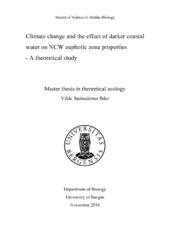| dc.contributor.author | Ihler, Vilde Steinsdotter | |
| dc.date.accessioned | 2017-01-13T16:42:37Z | |
| dc.date.available | 2017-01-13T16:42:37Z | |
| dc.date.issued | 2016-11-21 | |
| dc.date.submitted | 2016-11-21 | eng |
| dc.identifier.uri | https://hdl.handle.net/1956/15376 | |
| dc.description.abstract | The Norwegian Coastal Water (NCW) derives from an extensive outflow of freshwater from the Baltic Sea and river runoff from the Norwegian coast, making the water less saline than the North Atlantic Water (NAW). Freshwater components contain relatively large amounts of dissolved organic substances that absorb light, which have been suggested to make the NCW darker than the NAW. Such substances may have both marine and terrestrial origin and are often referred to as chromophoric dissolved organic matter (CDOM). An increased CDOM concentration is predicted in the freshwater component of the NCW in the future, with possible implications on the biological ecosystem. The water column model of nutrient and phytoplankton of Huisman et al. (2006) was applied to analyse how NCW euphotic zone properties would respond to changes in CDOM attenuation in a past, present and future scenario. This model was originally parameterized for subtropical conditions, i.e. for oligotrophic waters. I investigated the extent to which the model could reproduce the vertical distribution of nutrients and phytoplankton under NCW conditions, i.e. more eutrophic waters, using data from previously published studies from three fjord locations along southern Norway. Further, published studies on Secchi depth observation and predicted future changes in terrestrial organic matter were used as a proxy for CDOM supply to the freshwater draining to the NCW. IMRs fixed hydrographic stations have been used as a proxy for changes in salinity and stratification. My results suggest that the NCW euphotic zone properties are susceptible to variation in CDOM attenuation. The estimated changes in the NCW euphotic zone properties are also suggested to be greater in the future than those estimated for the past. From two coastal stations, Lista and Sognesjøen, it was suggested a 5 meter reduction in the euphotic depth from the present to a future scenario. Elevated CDOM attenuation in the future is also expected to show eutrophication like symptoms. However, the simulations also indicated lower primary production which means more oligotrophy rather than eutrophy. Shoaling and narrowing of the euphotic habitat due to elevated CDOM concentration, and also due to higher concentration of phytoplankton in the surface water, may provide implications on the biological community. | en_US |
| dc.format.extent | 8711205 bytes | eng |
| dc.format.mimetype | application/pdf | eng |
| dc.language.iso | eng | eng |
| dc.publisher | The University of Bergen | en_US |
| dc.subject | Kystfarvann | nob |
| dc.subject | Løst naturlig organisk materiale | nob |
| dc.subject | Planteplankton | nob |
| dc.subject | Norge | nob |
| dc.subject | Eufotisk sone | nob |
| dc.subject | Vannformørkning | nob |
| dc.title | Climate change and the effect of darker coastal water on NCW euphotic zone properties - A theoretical study | en_US |
| dc.type | Master thesis | |
| dc.rights.holder | Copyright the Author. All rights reserved | en_US |
| dc.description.degree | Master i Biologi | en_US |
| dc.description.localcode | MAMN-BIO | |
| dc.description.localcode | BIO399 | |
| dc.subject.realfagstermer | https://data.ub.uio.no/realfagstermer/c030753 | |
| dc.subject.realfagstermer | https://data.ub.uio.no/realfagstermer/c032075 | |
| dc.subject.realfagstermer | https://data.ub.uio.no/realfagstermer/c006601 | |
| dc.subject.realfagstermer | https://data.ub.uio.no/realfagstermer/c010560 | |
| dc.subject.realfagstermer | https://data.ub.uio.no/realfagstermer/c032074 | |
| dc.subject.realfagstermer | https://data.ub.uio.no/realfagstermer/c008279 | |
| dc.subject.nus | 751999 | eng |
| fs.subjectcode | BIO399 | |
